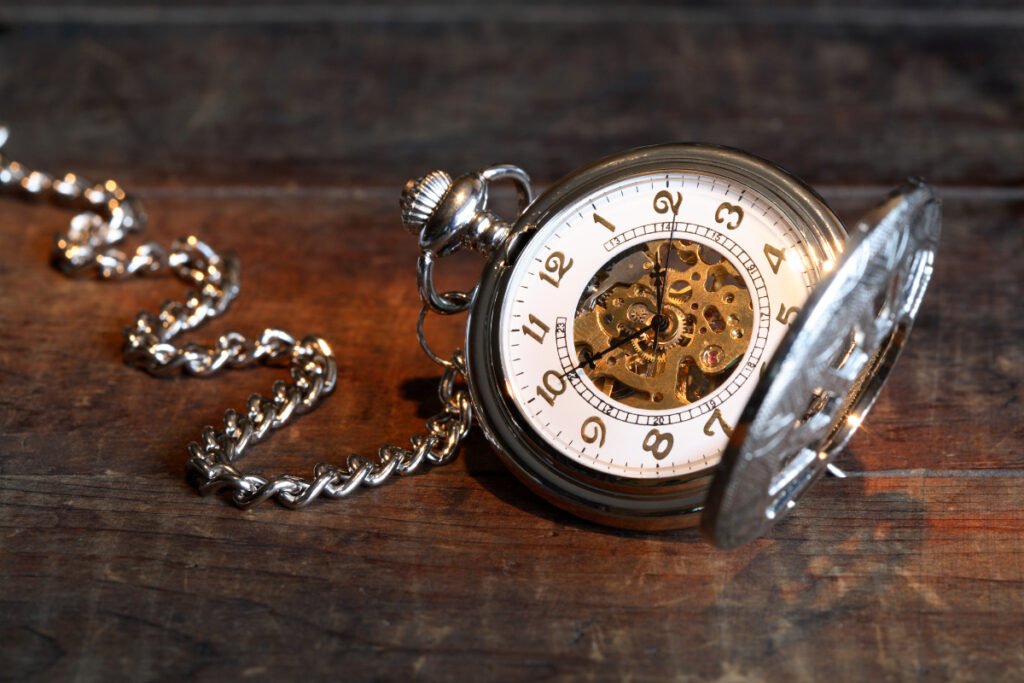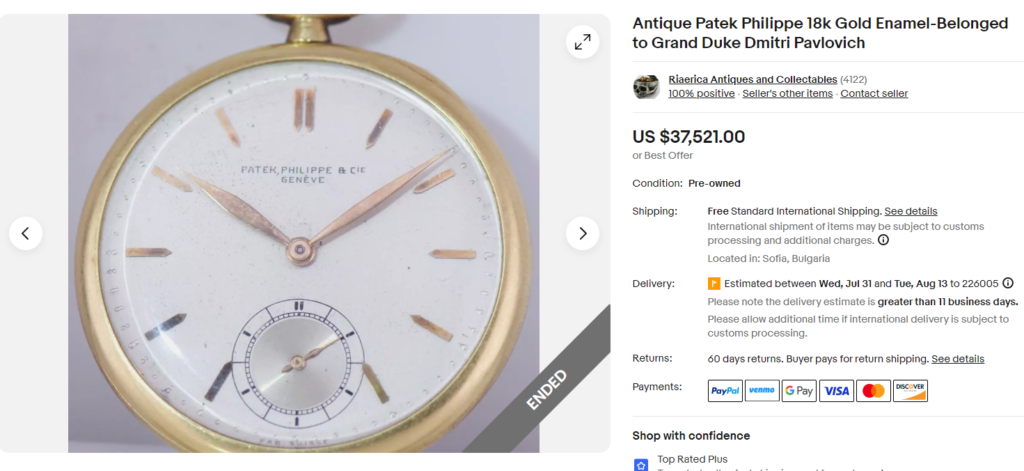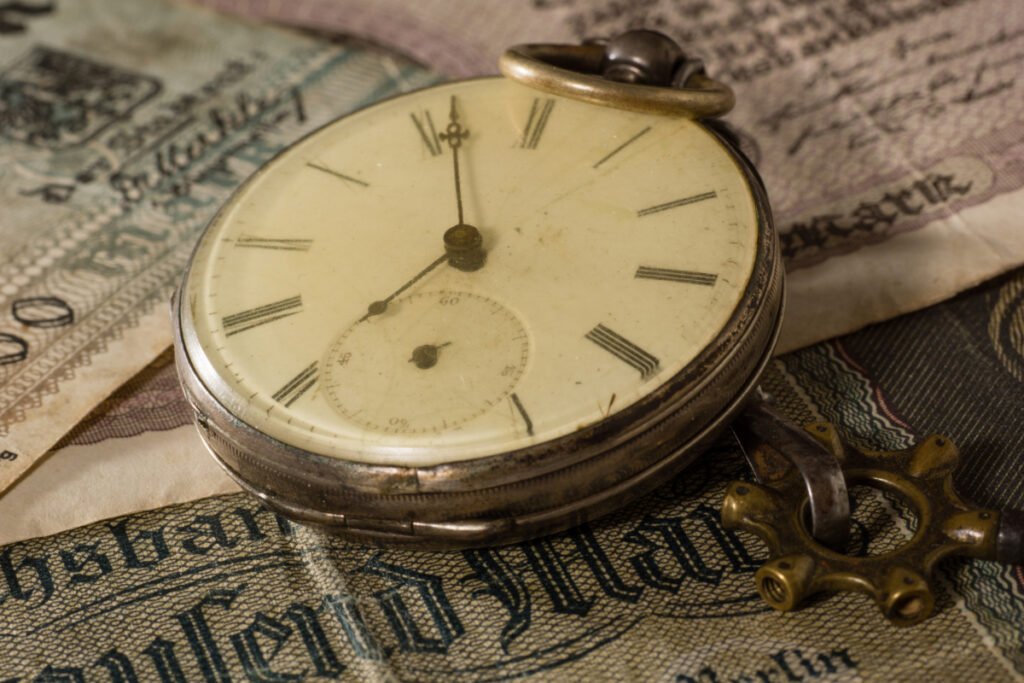Imagine owning an antique pocket watch that’s potentially worth millions, like the Patek Philippe Pocket Watch auctioned for $24 million in 2014. But how can you tell whether your old pocket watch is a priceless artifact or an ordinary timepiece?
Figuring out an old pocket watch’s value is tricky. It depends on its condition, brand, mechanism, movements, and how rare it is. Without identifying these features, you may miss out on an invaluable gem or purchase a worthless one for big bucks.
This guide makes it easy. You’ll learn how to spot vital details of your pocket watch. You’ll also be able to identify your pocket watch and get a good sense of its worth, whether buying or selling!
Key Takeaways
- Antique pocket watches bear different markings, like brand marks, jewel counts, hallmarks, location marks, and serial numbers.
- You can use the watch movement serial number to find more information from the company’s database.
- Patek Phillipe, Omega, Hamilton, Elgin, Hampden, and Waltham are some of the most sought-after pocket watch brands.
- An old pocket watch is worth a lot of money if it has hallmarked gold cases, painted, carved, or enameled cases, enamel dials, and sophisticated high-end watch movement.
4 Steps to Antique Pocket Watch Identification

Old pocket watch identification plays a crucial role in finding its true value. Learn some easy methods to identify your watch without professional help!
1. Checking the Serial Number (Using Database Serial LookUp)
The most trusted way to easily identify an American antique pocket watch and its age is by its serial number. You can do so with two easy steps:
Finding the Serial Number on the Pocket Watch
Technically, different parts of antique pocket watches are manufactured by different companies. So, you might see a few numerals (occasionally including letters) on the back or sides of the watch case and the movement.
The actual pocket watch serial number is marked on the watch movements inside the case.
You may also find the watch grade (size, finish, & jewel count) or the jewel count on the movement. But only use the serial number for the lookup!
LookUp the Serial Number on the Pocket Watch Database
Once you have the movement serial number, you can search for it on the PocketWatchDatabase LookUp.
All you have to do is enter the digits and select the right manufacturer from the drop-down list.

Here, you’ll have all the information about your pocket watch, like its manufacturing year, age, location, jewel, and more.
You can also identify and age your antique watch using the serial number tables of PM Time Service.
2. Identifying Pocket Watch Markings
Apart from serial numbers, you’ll find other markings on old pocket watches. The marks can help you identify a lot of valuable information about them.
- Brand or Watch Company Trademarks: You’ll find the brand trademarks or name on the watch dial, movement, or inside the back case. You may also see the symbols on the movement or case.
- Manufacturing Location Mark: The location mark is chiseled on the watch movements with the company name.
- Metal Purity Hallmarks: You’ll find unique material purity hallmarks on antique solid gold or silver pocket watch cases.
- Case Serial Number: The number on the outer or inner side of the back cover is the watch case serial number. These digits are only related to the case’s manufacturing, not the movement.
- Number of Jewels (Jewel Count): Jewel count is how many precious jewels like rubies and garnets are used in the watch mechanism. The jewel count is engraved on the movements. Occasionally, you can find it on the watch dial, too.
- Watch Grade: Pocket watch grade refers to its mechanism details, size, finish, jewel count, and design. The grade is occasionally marked on the movement. If it’s not, you can find it in the database lookup.
3. Identifying the Pocket Watch Type

You can identify the “type” of your antique pocket watch by analyzing its dial, case, movements, and wind-set systems.
1. Open Face:
- Features: Open-face watches have no metal cover on the front. Usually, all railroad pocket watches are open-face.
- Crown Position: 12 o’clock.
2. Full Hunter:
- Features: A full hunter case features a spring-hinged metal cover on the face.
- Crown Position: 3 o’clock.
3. Double Hunter:
- Features: The pocket watches with Double Hunter case have metal lids on the watch face and the back.
- Crown Position: 3 o’clock.
4. Demi or Half Hunter:
- Features: A Demi Hunter Case watch has a hinged cover with a small window to check the time without opening the case. The metal covers have numbers (or Roman numbers) marked on them.
- Crown Position: 3 o’clock.
5. Sidewinder:
- Features: A sidewinder is basically an open-face pocket watch with a hunter-case movement.
- Crown Position: 3 o’clock.
6. Pair-Cased:
- Features: A cased watch has two cases; the inner one holds the watch, while the outer case protects the body.
- Crown Position: 12 o’clock or 3 o’clock
8. Chronograph:
- Features: Chronograph watches have built-in stopwatch functions. So, you’ll see subdials for minutes and hours and a few buttons to operate the chronograph functions.
- Crown Position: 12 o’clock or 3 o’clock.
9. Repeater:
- Features: A repeater pocket watch doesn’t just display the time but chimes it on demand. Based on the chiming intervals, there are hour, minute, quarter, half-quarter, five-minute repeater watches.
- Crown Position: 12 o’clock or 3 o’clock.
4. Identifying the Watch Movements & Mechanisms

The movement is the machinery that runs the pocket watch. You can access the watch movements by opening its back case.
The type of watch movement can help you age the watch as different movements belong to different eras. You may find one of the four movements in old watches:
1. Key-Wind, Key-Set:
- Period: 1600s-1850s
- Function: This is the earliest watch movement that requires a separate key to wind the spring and set the time.
2. Stem-wind, Stem-Set:
- Period: 1840s-1900s
- Function: You can wind the spring and set the time using a stem (with crown). Pulling the crown enables the setting mode, and pushing it winds the watch up.
3. Stem-wind, Lever-Set (Common in Railroad Watches):
- Period: 1900s-Mid 1900s
- Function: This movement allows you to enter time setting mode using a lever, which is hidden under the front bezels. You can set the time and wind the watch using the stem & crown. Lever out-set, Lever in-lock & wind!
4. Stem-Wind, Pin-Set/Nail Set:
- Period: Early 20th Century
- Function: This movement uses a tiny pin or button near the crown to set the time. You must press the pin, hold it in, and rotate the crown to set the time.
How to Find Antique Pocket Watches Value in 6 Steps

The value of an antique pocket watch depends on factors like brand, condition, rarity, size, and mechanism. Generally, unbranded old pocket watches in poor (non-working) condition aren’t worth over $100-$200.
A simple watch from a lesser-known brand might fetch $500-$800. But fully jeweled pocket watches with complex mechanisms from brands like Patek Philippe or Hamilton can be worth thousands!
Don’t believe me? A rare Limited Edition Patek Philippe 18k Gold Enamel Pocket Watch was sold for $37,521 on eBay.

So, let’s understand how to estimate your antique pocket watch value correctly!
1. Examine the Rarity of Pocket Watches
To appraise an old pocket watch, the first thing you should analyze is its rarity. So, find all the information on how many models were made using the serial number lookup.
The smaller production line means that very few models of the specific pocket watch are in the market, making it rare. The rarer the watch, the more value you can expect.
2. Identify the Pocket Watch Brand

The value of old pocket watches largely depends on their name or the brand! So, first thing, know which brand your pocket watch is.
Swiss brands like Patek Phillipe, Breguet, Vacheron, George Daniels, and Omega are the most desirable names for European antique watches.
Similarly, Elgin, Hamilton, Hampden, Howard, and Waltham made the best ‘high-value’ American pocket watches worldwide. Such branded watches can be worth hundreds or thousands of dollars in even average condition.
In fact, some rare pieces can also surpass the million mark, and they have done so in the past! The following rare vintage watches sold at auctions for record-setting prices:
- The most expensive antique pocket watch ever sold is the Swiss Patek Philippe Henry Graves Supercomplication, auctioned for $24 million at Sotheby’s in Geneva in November 2014.
- 1989-made Patek Philippe’s Yellow Gold Calibre Pocket Watch fetched over $5 million at Antiquorum Auctioneers in Geneva in 2009.
- 19th Century Breguet & Fils (No. 2667) Pocket Watch sold for $4.7 million at Christie’s in 2012.
- In 2019, a George Daniels’ Yellow Gold Space Traveller’s Pocket Watch (1982) won the Sotheby’s auction at $4.5 million in London.
The branded watches mentioned above are extremely rare. That’s why they have sky-high prices.
You can also find common or less rare models of branded watches under $1,000 or even $500 on sites like eBay (sales or auctions), Etsy, RubyLane, and Mercari.
3. Observe the Material (Pocket Watch Case & Dial)

As a thumb rule, antique pocket watches made of exotic metals like gold, silver, and platinum cases are more desirable than base metal watches.
- Gold Case: Real 14k, 18k, and “750” hallmarked gold case pocket watches are worth more than gold-plated or filled unmarked watches. Besides, you can value elaborate gold cases with intricate carvings, enamel paintings, and precious stones more.
- Silver Case: Silver pocket watches are less valuable than gold, around only $300 – $800. However, rare models with enamel painting or decoration can fetch thousands. This rare Carl Neumann of Berlin Silver Pocket Watch sold for $33,600 on Etsy!
- Platinum Case: Rare old pocket watches with platinum cases are precious, worth $1,000 – $20,000 or more. This value also depends on the rarity, brand, and condition.
- Nickel or Bronze Case: Nickel or bronze pocket watches aren’t as desirable as gold or silver watches. So, these are generally worth less.
Apart from the body material, the dial material can also impact the value of an old pocket watch. Generally, a pocket watch with enamel porcelain dials is valued more than ordinary metal dials.
4. Assess the Condition

The antique pocket watch should be in good condition to be worth the money. Minor scratches, dents, and hairline cracks on the dial are okay, but the watch should likely be operational.
Collectors don’t value damaged pocket watches with twisted or missing hands and cracked or chipped enamel dials. Also, dented cases, bent hinges, and broken face glass are a big no for them.
But they may still pay a decent price for slightly damaged watches if they’re rare or branded.
5. Find the Jewel Count
Valuable old pocket watches use jewels like rubies, garnets, emeralds, diamonds, and sapphires to reduce friction in the watch movement. You can find the jewel count marked on the movement plate inside the case.
Generally, a pocket watch may have 7-24 jewels in its mechanism, hinting at its quality and worth. You can also grade pocket watches based on the jewel count:
- Lower-Grade: Below 15 or 12 Jewels
- Mid-Grade: 15-18 Jewels
- Higher-Grade: 19-23 Jewels
- Extremely Rare: 24+ Jewels
The number of jewels directly impacts the value of old pocket watches; the higher the jewel count, the more valuable pocket watches are. A common pocket watch with 7 – 24 jewels is worth $500-$1,000, while rare ones can fetch thousands!
If the jewel count is not mentioned on the movement plate, you may contact a watchmaker to find it.
6. Look for Original Boxes and Papers
Original boxes and certificates greatly add to old pocket watch values. They can tell you its model name, serial number, watch case number, location, etc. So, collect the original paperwork and boxes before selling or purchasing a watch.
Interesting History of Antique Pocket Watches
The credit for popularizing spring-driven pocket watches goes to locksmith Peter Henlein. These early 16th-17th century antique watches were quite big, so people wore them around the neck using a chain.
During the 1700s, makers introduced smaller fancy watches small enough to be kept in pockets. Soon, these watches became more usable after Thomas Mudge improved the accuracy of the timing.
In the 1800s, Patek Philippe Co-founder Adrien Philippe invented the keyless winding and setting system. This mechanism made the pocket watch easier to operate and, hence, more popular!
Pocket watches arrived in America in the 1850s via Waltham Watch Co. Soon; other companies started making high-end models with better mechanisms. But with the rise of wristwatches in the 1910s, they became more popular as collectibles!
Identifying an antique pocket watch and finding its worth may be exhaustive. But this detailed guide will help you get started with your old pocket watch identification easily.
If you want to learn especially about Waltham Pocket Watches Identification or other valuable pocket watch brands, the linked guides will be helpful!
Note: This article is intended for informational, educational, and entertainment purposes only. Some images are illustrative and may not represent actual brands, products, or related entities. All trademarks, product names, brand logos, packaging, and other intellectual property referenced remain the exclusive property of their respective owners. Any brand mentions or references are provided solely for descriptive and educational context and do not imply any formal or commercial association.










